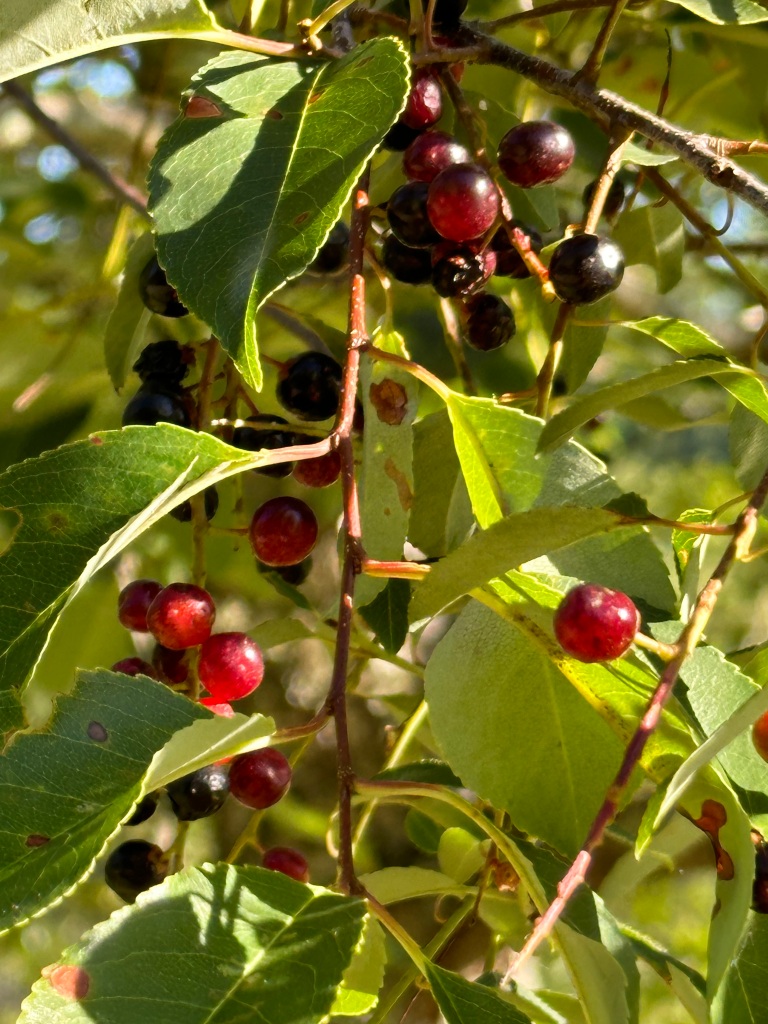
Recently, I noticed the black cherries (Prunus serotina) had a red cast to the crown of the trees. It’s similar to the look of red maples earlier in the spring when their ruby flowers, then winged seeds (also called samara, schizocarp, or ‘helicopters’) flamed the canopies. But blossoms of the wild cherries are tiny, white and arranged in 3” long clusters (racemes). The flowers are long since gone this year, so I knew it wasn’t that.
Getting closer, I was stunned to see the trees were absolutely full of fruit. I’ve never seen such a heavy fruit set. The small cherries (.3”) are first green, then red, then black once ripe. Black cherry trees begin bearing fruit at about 10 years old. Only bearing heavily after 30 years and under optimal weather conditions. Apparently, that was the case for the cherries around here this year.
I sometimes read the cherries are too bitter to eat, but I’ve not found that to be true. If fully ripe, most are pretty tasty. Of course, you should never eat plants in the wild unless you’re absolutely sure about the identification.
As you might guess, I’m not the only one who likes the cherries. Raccoons, opossums, deer, foxes and most mammals, plus many birds relish the berries. We once opened a bird house for cleaning at the end of the season and found the back corner full of about 30 cherry pits.
According to the Georgia DNR, the widely distributed tree is reportedly the host for 454 kinds of butterflies and moths. Including the gorgeous ‘red-spotted purple’ butterfly (more aptly name an orange-spotted blue, but that’s a different article) the big yellow and black eastern tiger swallowtail, orange viceroys, and huge, brown promethea moths. Fragrant flowers attract bees and other pollinators. Black cherries are second only to oaks in providing resources for wildlife.
Leaves are a basic oval shape with tiny teeth on the edge. An identifier for this common shaped leaf is the presence of light brown fur along the center vein on the bottom third of the leaf back. Though the leaves are poisonous to domestic livestock, deer and other wildlife seem unaffected.
Cherry bark is thin and silvery with darker and lighter horizontal stripes. Older trees may have very rough patches of warty black bark. With age, the bark gets very flaky. If you’ve seen it a few times, the bark is an easy identifier. Bark is still used in some cough remedies. And the wood is still considered one of the best choices for fine furniture.
Though the tree is deemed by some to be ‘trash tree’—possibly because many of them don’t live long—with the high value to wildlife, it is a tree worth keeping in your landscape.


Hi Donna,
<
div>I’m
LikeLike
Donna, I hope you are well. This seems to be a massive fruit set for all fruit trees this year. Our apples, peaches, plums, etc. are all heavily laden. What fun! I love all of your articles. I enjoy them every week!
Get Outlook for iOShttps://aka.ms/o0ukef ________________________________
LikeLike
I think the intermittent rains over the last year or so have primed a lot of plants for big floral displays and fruit sets. It’s such a relief not to be in a drought. I’m gratified to hear you enjoy the columns. I learn something writing every one of them.
LikeLike
We ate those from the woods a lot in our youth years, along with plumbs, figs, and muscadines. Tried to make wine with them too. Oh blackberry too. Surely miss those taste.
LikeLike
I snacked on some blackberries during my morning walk the other day. And I helped myself to one sand plum recently. There are normally only a few fruits so I save them for the wildlife, but this plum was a little overripe and I really wanted to see if it tastes as good as it looked. It was delish! I saved the seed to plant nearby. I’ve eaten muscadines in the wild so many times. Yum!
LikeLike